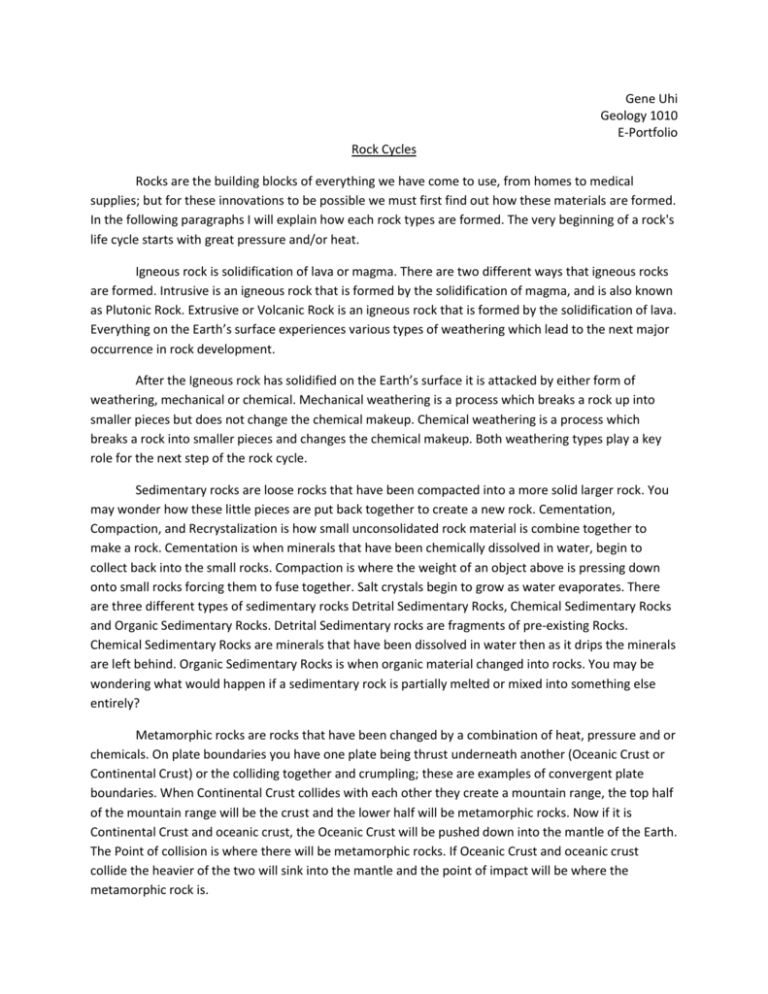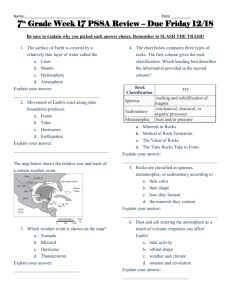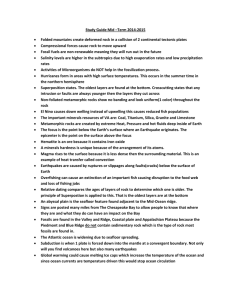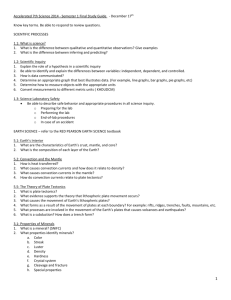File - Gene Uhi`s ePortfolio
advertisement

Gene Uhi Geology 1010 E-Portfolio Rock Cycles Rocks are the building blocks of everything we have come to use, from homes to medical supplies; but for these innovations to be possible we must first find out how these materials are formed. In the following paragraphs I will explain how each rock types are formed. The very beginning of a rock's life cycle starts with great pressure and/or heat. Igneous rock is solidification of lava or magma. There are two different ways that igneous rocks are formed. Intrusive is an igneous rock that is formed by the solidification of magma, and is also known as Plutonic Rock. Extrusive or Volcanic Rock is an igneous rock that is formed by the solidification of lava. Everything on the Earth’s surface experiences various types of weathering which lead to the next major occurrence in rock development. After the Igneous rock has solidified on the Earth’s surface it is attacked by either form of weathering, mechanical or chemical. Mechanical weathering is a process which breaks a rock up into smaller pieces but does not change the chemical makeup. Chemical weathering is a process which breaks a rock into smaller pieces and changes the chemical makeup. Both weathering types play a key role for the next step of the rock cycle. Sedimentary rocks are loose rocks that have been compacted into a more solid larger rock. You may wonder how these little pieces are put back together to create a new rock. Cementation, Compaction, and Recrystalization is how small unconsolidated rock material is combine together to make a rock. Cementation is when minerals that have been chemically dissolved in water, begin to collect back into the small rocks. Compaction is where the weight of an object above is pressing down onto small rocks forcing them to fuse together. Salt crystals begin to grow as water evaporates. There are three different types of sedimentary rocks Detrital Sedimentary Rocks, Chemical Sedimentary Rocks and Organic Sedimentary Rocks. Detrital Sedimentary rocks are fragments of pre-existing Rocks. Chemical Sedimentary Rocks are minerals that have been dissolved in water then as it drips the minerals are left behind. Organic Sedimentary Rocks is when organic material changed into rocks. You may be wondering what would happen if a sedimentary rock is partially melted or mixed into something else entirely? Metamorphic rocks are rocks that have been changed by a combination of heat, pressure and or chemicals. On plate boundaries you have one plate being thrust underneath another (Oceanic Crust or Continental Crust) or the colliding together and crumpling; these are examples of convergent plate boundaries. When Continental Crust collides with each other they create a mountain range, the top half of the mountain range will be the crust and the lower half will be metamorphic rocks. Now if it is Continental Crust and oceanic crust, the Oceanic Crust will be pushed down into the mantle of the Earth. The Point of collision is where there will be metamorphic rocks. If Oceanic Crust and oceanic crust collide the heavier of the two will sink into the mantle and the point of impact will be where the metamorphic rock is. There are two different types of metamorphic rocks, foliated metamorphic rocks and nonfoliated metamorphic rocks. Foliated metamorphic rocks are preferred orientation and or preferred distribution of the mineral crystals in a metamorphic rock. Preferred orientation is where the crystals are all pointing the same direction. Preferred distribution is where the crystals are spaced apart precisely. Preferred orientation and distribution is where the crystals are spaced precisely and pointed in the same direction. Non-foliated Metamorphic Rocks are the complete opposite of Foliated metamorphic rocks; they are more chaotic in their preferred orientation and distribution. After igneous rocks are formed they can take one of two roads, one is weathering and the other is changing into a metamorphic rock but for now let’s say that it undergoes weathering and changes. Once weathering has occurred on the igneous rock it will change into sediments. Then the lithification process begins and changes the sediments into Sedimentary Rocks. After Sedimentary Rocks have formed it can take one of two roads it can go back and be re-weathered or go forward and be changed into a metamorphic rock. Once the metamorphic rock has finished it can take one of three roads, go to the beginning and be changed into a sedimentary rock or go back and go through metamorphism again or go forward be cooked to melting point and start the whole process all over again, which is called the Rock Cycle. The rock cycle is a vast cycle which repeats. Below is the full rock cycle.








